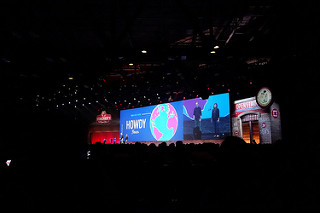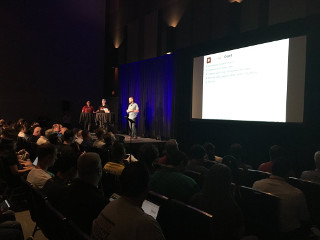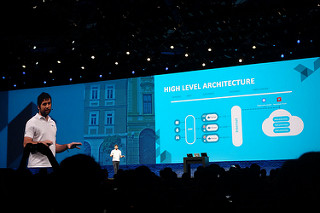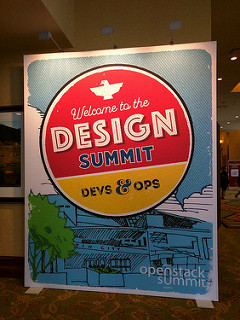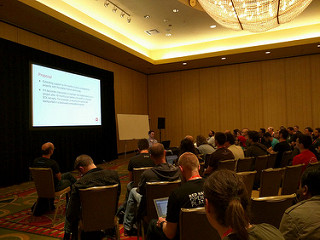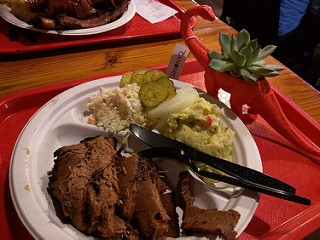This past week I attended my sixth OpenStack Summit. This one took us to Austin, Texas. I was last in Austin in 2014 when I quickly stopped by to give a talk at the Texas LinuxFest, but I wasn’t able to stay long during that trip. This trip gave me a chance (well, several) to finally have some local BBQ!
I arrived Sunday afternoon and took the opportunity to meet up with Chris Aedo and Paul Belanger, who I’d be on the stage with on Monday morning. We were able to do our first meetup together and do a final once through of our slides to make sure they had all the updates we wanted and we were clear on where the transitions were. Gathering at the convention center also allowed to pick up our badges before the mad rush that would come the opening of the conference itself on Monday morning.
With Austin being the Live Music Capital of the World, we were greeted in the morning by live music from the band Soul Track Mind. I really enjoyed the vibe it brought to the morning, and we had a show to watch as we settled in and waited for the keynotes.
Jonathan Bryce and Lauren Sell of the OpenStack Foundation opened the conference and gave us a tour of numbers. The first OpenStack summit was held in Austin just under six years ago with 75 people and they were proud to announce that this summit had over 7,500. It’s been quite the ride that I’m proud to have been part of since the beginning of 2013. In Jonathan’s keynote we were able to get a glimpse into the real users of OpenStack, with highlights including the fact that 65% of respondents to the recent OpenStack User Survey are using OpenStack in production and that half of the Fortune 100 companies are using OpenStack in some capacity. It was also interesting to learn how important the standard APIs for interacting with clouds was for companies, a fact that I always hoped would shine through as this open source cloud was being adopted. The video from his keynote is here: Embracing Datacenter Diversity.
As the keynotes continued the ones that really stood out for me were by AT&T (video: AT&T’s Cloud Journey with OpenStack) and Volkswagen Group (Driving the Future of IT Infrastructure at Volkswagen Group.
The AT&T keynote was interesting from a technical perspective. It’s clear that the rise of mobile devices and the internet of things has put pressure on telecoms to grow much more quickly than they have in the past to handle this new mobile infrastructure. Their keynote shared that they expected this to grow an additional ten times by 2020. To meet this need, the networking aspects of technologies like OpenStack are important to their strategy as they move away from “black box” hardware from networking vendors and to more software-driven infrastructure that could grow more quickly to fit their needs. We learned that they’re currently using 10 OpenStack projects in their infrastructure, with plans to add 3 more in the near future, and learned about their in house AT&T Integrated Cloud (AIC) tooling for managing OpenStack. When the morning concluded, all their work was rewarded with a Super User award, they wrote about here.
The Volkswagen Group keynote was a lot of fun. As the world of electric and automated cars quickly approaches they have recognized the need to innovate more quickly and use technology to get there. They still seem to be in the early days of OpenStack deployments, but have committed a portion of one of their new data centers to just OpenStack. Ultimately they see a hybrid cloud future, leveraging both public and private hosting.
The keynote sessions concluded with the announcement of the 2017 OpenStack Summit locations: Boston and Sydney!
Directly after the keynote I had to meet Paul and Chris for our talk on OpenStack Infrastructure for Beginners (video, slides). We had a packed room. I lead off the presentation by covering an overview of our work and by giving a high level tour of the OpenStack project infrastructure. Chris picked up by speaking to how things worked from a developer perspective, tying that back into how and why we set things up the way we did. Paul rounded out the presentation by diving into more of the specifics around Zuul and Jenkins, including how our testing jobs are defined and run. I think the talk went well, we certainly had a lot of fun as we went into lunch chatting with folks about specific components that they were looking either to get involved with or replicate in their own continuous integration systems.
After a delicious lunch at Cooper’s BBQ, I went over to a talk on “OpenStack Stable: What It Actually Means to Maintain Stable Branches” by Matt Riedemann, Matthew Treinish and Ihar Hrachyshka in the Upstream Development track of the conference. This was a new track for this summit, and it was great to see how well-attended the sessions ended up being. The goal of this talk was to inform members of the community what exactly is involved in management of stable releases, which has a lot more moving pieces than most people tend to expect. Video from the session up here. It was then over to “From Upstream Documentation To Downstream Product Knowledge Base” by Stefano Maffulli and Caleb Boylan of DreamHost. They’ve been taking OpenStack documentation and adjusting it for easier and more targeted for consumption by their customers. They talked about their toolchain that gets it from raw source from the OpenStack upstream into the proprietary knowledge base at DreamHost. It’ll be interesting to see how this scales long term through releases and documentations changes, video here.
My day concluded by participating in a series of Lightning Talks. My talk was first, during which I spent 5 minutes giving a tour of status.openstack.org. I was inspired to give this talk after realizing that even though the links are right there, most people are completely unaware of what things like Reviewday (“Reviews” link) are. It also gave me the opportunity to take a closer, current look at OpenStack Health prior to my presentation, I had intended to go to “OpenStack-Health Dashboard and Dealing with Data from the Gate” (video) but it conflicted with the talk we were giving in the morning. The lightning talks continued with talks by Paul Belanger on Grafyaml, James E. Blair on Gertty and Andreas Jaeger on the steps for adding a project to OpenStack. The lightning talks from there drifted away from Infrastructure and into more general upstream development. Video of all the lightning talks here.
Day two of the summit began with live music again! It was nice to see that it wasn’t a single day event. This time Mark Collier of the OpenStack Foundation kicked things off by talking about the explosion of growth in infrastructure needed to support the growing Internet of Things. Of particular interest was learning about how operators are particularly seeking seamless integration of virtual machines, containers and bare metal, and how OpenStack meets that need today as a sort of integration engine, video here.
The highlights of the morning for me included a presentation from tcp cloud in the Czech Republic. They’re developing a Smart City in the small Czech city of PÃsek. He did an overview of the devices they were using and presented a diagram demonstrating how all the data they collect from around the city gets piped into an OpenStack cloud that they run. He concluded his presentation by revealing that they’d turned the summit itself into a mini city by placing devices around the venue to track temperature and CO2 levels throughout the rooms, very cool. Video of the presentation here.
I also enjoyed seeing Dean Troyer on stage to talk about improving user experience (UX) with OpenStackClient (OSC). As someone who has put a lot of work into converting documented commands in my book in an effort to use OSC rather than the individual project clients I certainly appreciate his dedication to this project. The video from the talk is here. It was also great to hear from OVH, an ISP and cloud hosting provider who currently donates OpenStack instances to our infrastructure team for running CI testing.
Tuesday also marked the beginning of the Design Summit. This is when I split off from the user conference and then spend the rest of my time in development space. This time the Design Summit was held across the street from the convention center in the Hilton where I was staying. This area of the summit takes us away from presentation-style sessions and into discussions and work sessions. This first day focused on cross-project sessions.
This was the lightest day of the week for me, having a much stronger commitment to the infrastructure sessions happening later in the week. Still, went to several sessions, starting off with a session led by Doug Hellmann to talk about how to improve the situation around global requirements. The session actually seemed to be an attempt to define the issues around requirements and get more contributors to help with requirements project review and to chat about improvements to tests. We’d really like to see requirements changes have a lower chance of breaking things, so trying to find folks to sign up to do this test writing work is really important.
I had lunch with my book writing co-conspirator Matt Fischer to chat about some of the final touches we’re working on before it’s all turned in. Ended up with a meaty lunch again at Moonshine Grill just across the street from the convention center, after which I went into a “Stable Branch End of Life Policy” session led by Thierry Carrez and Matt Riedemann. The stable situation is a tough one. Many operators want stable releases with longer lifespans, but the commitment from companies to put engineers on it is extremely limited. This session explored the resources required to continue supporting releases for longer (infra, QA, etc) and there were musings around extending the support period for projects meeting certain requirements for up to 24 months (from 18). Ultimately by the end of the summit it does seem that 18 months continues to be the release lifespan of them all.
I then went over to the Textile building across from the conference center where my employer, HPE, had set up their headquarters. I had a great on-camera chat with Stephen Spector about how open source has evolved from hobbyist to corporate since I became involved in 2001. I then followed some of the marketing folks outside to shoot some snippits for video later.
The day of sessions continued with a “Brainstorm format for design summit split event” session that talked a lot about dates. As a starting point, Thierry Carrez wrote a couple blog posts about the proposal to split the design summit from the user summit:
- Splitting out the OpenStack Design Summit
- How splitting the Design Summit enhances the development process
With these insightful blog posts in mind, the discussion moved forward on the assumption that the events would be split and how to handle that timing-wise. When in the cycle would each event happen for maximum benefit for our entire community? In the first blog post he had a graphic that had a proposed timeline, which the discussions mostly stuck to, but dove deeper into discussing what is going on during each release cycle week and what the best time would be for developers to gather together to start planning the next release. While there was good discussion on the topic, it was clear that there continues to be apprehension around travel for some contributors. There are fears that they would struggle to attend multiple events funding-wise, especially when questions arose around whether mid-cycle events would still be needed. Change is tough, but I’m on board with the plan to split out these events. Even as I write this blog post, I notice the themes and feel for the different parts of our current summit are very different.
My session day concluded with a session about cross-projects specifications for work lead by Shamail Tahir and Carol Barrett from the Product Working Group. I didn’t know much about OpenStack user stories, so this session was informative for seeing how those should be used in specs. In general, planning work in a collaborative way, especially across different projects that have diverse communities is tricky. Having some standards in place for these specs so teams are on the same page and have the same expectations for format seems like a good idea.
Tuesday evening meant it was time for the StackCity Community Party. Instead of individual companies throwing big, expensive parties, a street was rented out and companies were able to sponsor the bars and eateries in order to throw their branded events in them. Given my dietary restrictions this week, I wasn’t able to partake in much of the food being offered, so I only spent about an hour there before joining a similarly restricted diet friend over at Iron Works BBQ. But not before I picked up a dinosaur with a succulent in it from Canonical.
I called it an early night after dinner, and I’m glad I did. Wednesday through Friday were some busy days! But those days are for another post.
More photos from the summit here: https://www.flickr.com/photos/pleia2/albums/72157667572682751


